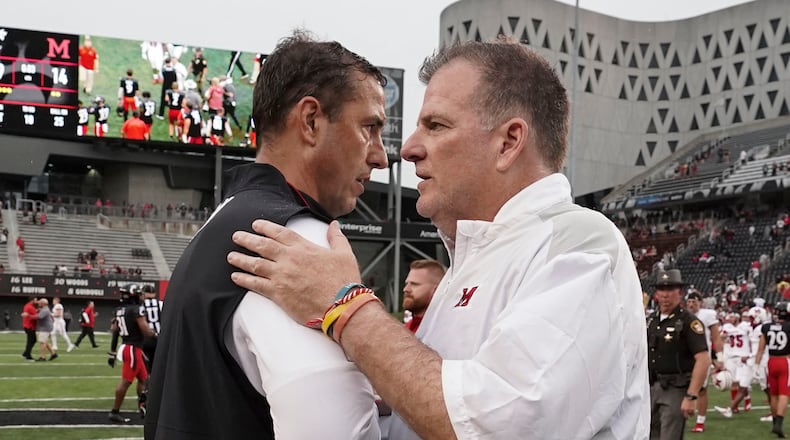“They’re preparing to protect our country, and there’s one rule in war — win at all costs,” Martin said during Monday’s weekly media session. “They fight and scratch and claw for every inch. That’s how they’re trained. They play like they’re storming the hill, but the only difference is nobody’s shooting at them. It’s just a bunch of you clowns playing football. The problem is that’s how they play football.
“Do they intentionally do anything illegal? No, not intentionally. It’s awesome to watch. If I trained my guys to play like that, I’d be fired. It’s tough enough to play for three hours on Saturday. Then you have to go up against that. That’s the challenge.”
Martin described one play he and his assistants saw while watching video of a recent Army-Navy game.
“There were 20 bodies on the ground at the end of the play,” he said. “There’s only 22 guys on the field. I’ve never seen a play that ended with 20 bodies on the ground. It was like somebody stepped on a mortar.”
Besides aggressiveness, Army also presents an unusual challenge with its triple-option offense, which was popular in the 1970s but is rarely seen now. The 3-0 Black Knights are averaging 44.3 points and 331.3 rushing yards per game. Seven different players average at least 30 yards rushing per game.
“They have a completely different offense,” said 6-foot-2, 284-pound sophomore defensive tackle Austin Ertl, who practiced daily against the triple-option at Wauwatosa (Wis.) West High School. “It’s a big challenge for the defense when they come at you. For me, it’s awesome to not know what’s coming at me. It might be one guy. It might be two guys. It might be three guys. All we can do is show what we as a defense can do as whole.”
Martin admitted that it’s difficult to prepare in one week for the unusual attack.
“They’ve got 40 plays,” he said. “The best scout team against Army is the first quarter.”
Miami, 0-2 on the road and 1-2 overall after a 42-7 win over Football Championship Subdivision Long Island University-Post last Saturday, and Army have played six times in a series dating back to 1960 with each team winning three, including the Black Knights’ 31-30 double-overtime win in 2018. That game included Miami stopping Army on first-and-goal from the 5-yard line late in the first half and Miami’s comeback from a 14-point deficit to force overtime with two touchdowns in the last five minutes. The Black Knights escaped when they took a touchdown lead in the second overtime and Miami fell short on an attempted two-point conversion pass that would have won the game.
Wide receiver Jalen Walker, a redshirt freshman in that game, finished with eight catches for 71 yards. He caught just four passes the rest of the season.
“I had a couple of opportunities the last time,” he said. “I was able to make a couple of plays. It was a great experience.”
Army was scheduled to play at Miami’s Yager Stadium last season in a game cancelled by pandemic protocols. The Black Knights aren’t on future Miami schedules through 2029, according to the Miami athletics website.
Miami and Army also have a “Cradle of Coaches” connection. Earl “Red” Blaik played at Miami from 1915 through 1917 before moving on to Army. He spent two seasons as a Miami assistant before eventually beginning in 1941 an 18-year career as Army’s coach. His teams won Associated Press national championships in 1944 and 1945 and he coached three Heisman Trophy winners: Doc “Mr. Inside” Blanchard in 1945; Glenn “Mr. Outside” Davis in 1946; and Pete Dawkins in 1958.
Blaik passed away in 1989 and is buried at West Point. He is one of nine Miami graduates who went on to impressive coaching careers to be honored with statues at the Cradle of Coaches Plaza at the south end of Yager Stadium.
About the Author
